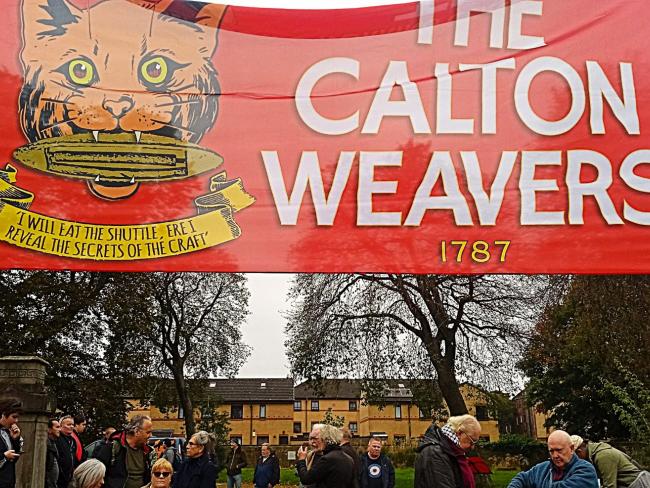16 August 2025

The Calton Weavers commemoration gathering at Abercrombie Street Burial Grounds on September 22, 2024, Photo Workers.
In 1787, at the outset of the industrial revolution, Glasgow workers began to organise. Six were shot and many injured, they are not forgotten.
The Calton Weavers commemorative campaign is building towards the 240th anniversary of the killing of striking workers and the wounding of many more, in the Calton area of Glasgow in 1787.
Annual events featuring talks, music and poetry will lead to a major commemoration and memorial unveiling in 2027.
Frederick Engels placed the beginning of Britain’s industrial revolution to the middle of the 18th century. He based his view on two main advances in science, the invention of the steam engine and the development of machines for use in spinning and weaving.
‘The strike action of the weavers of Calton marked the start of an organised labour movement.’
Workers in Scotland had rejected feudalism and the Stewart dynasty in 1745; they found themselves at the forefront of the emergent industrial revolution. Tailors were on strike in Edinburgh in 1748 and in Aberdeen in 1763, followed by the weavers of Paisley in 1773. But it was the strike action of the weavers of the Calton area of Glasgow in 1787 that marked the start of an organised labour movement.
Over 20,000 hand-loom weavers were at work in the west of Scotland in the 1780s. The cloth they produced formed a major part of Glasgow’s commercial success, the growth of its merchants’ riches and the expansion of the city.
Exploitation
The new capitalist class benefited from the trans-Atlantic “triangular trade” combining cotton, tobacco and slaves. And the outcome for workers was increased exploitation. These were the days before the power loom: whole families including children worked in the largely home-based industry.
Within the concentrated working population solidarity grew and the workers became a powerful force. Calton in the east end of Glasgow had such a workforce. It was there in the 1730s that the workers had formed their first associations. Other areas of Glasgow followed – Anderston in 1738, Pollokshaws in 1749 and Govan in 1756. In 1761 the weavers in Fenwick, south of Glasgow, formed the first co-operative society in Britain.
Deadly attack
In 1787 early capitalism was in crisis. The import of cheap muslin from India caused prices to plummet – leaving weavers working longer for less pay. After wages were cut by a quarter, they held a mass rally in June 1787 at Glasgow Green (where workers still rally today). A resolution was passed to refuse to work at the reduced rates.
Employers immediately had the strike declared illegal and offered 20 guineas to informers. On 3 September that the situation escalated with strikers stopping scabs from accepting the low price raw materials. The manufacturers summoned the army who attacked the strikers and surrounded the whole district overnight.
Arrests
Six workers died of gunshots and many more were wounded: 6,000 strikers attended their burial. Mass arrests followed including those of whole families.
One leader – James Granger – was sentenced to be whipped through the streets of Edinburgh and then banished from Scotland for 7 years. However, he returned to become a leader in the movement that led to “the great strike” associated with the Luddites in 1811-1812.
Fear
The fear of the manufacturers and the ruling class of the time can be seen in the construction of the infantry barracks that opened in 1795, strategically sited in the Gallowgate right beside the Calton district.
In contrast to the fate of the strikers, the army officers involved were given “the freedom of the city”. Part of the current commemorative campaign is to secure the revoking of this freedom of the city. Direct descendants of the massacred weavers are demanding that Glasgow City Council overturn it, especially in the case of Lieutenant Colonel Kellet who organised the massacre.
Inspiration
Although this strike met a bloody end, its example was not forgotten by workers. By 1812 the United Committee of Framework Knitters was in existence in greater Glasgow, Nottingham, London, Derby and Dublin. The grievances – and the spirit – of the Calton weavers were shared throughout Britain. By 1820 the Glasgow Association of Cotton Spinners had organised the workforce.
The repression of the Calton Weavers foreshadowed the events in working class history such as the 1819 Peterloo massacre, the deportation of the Tolpuddle martyrs in 1834 and the 1919 attacks on Glasgow strikers in George Square.
The efforts to commemorate and celebrate the Calton Weavers should be supported. The events of 1787 were a watershed moment in working class history.
Educated
The 24 September 2023 Calton Weavers commemoration event featured music and several speakers. Jennifer McCarey, chair of Glasgow Trade Union Council, said, “And of course the weavers were intelligent, articulate, well organised workers. We might think of workers at this period of time as living some kind of peasant existence. In fact, not only were they educated themselves, but they saw education as essential for their colleagues and for others and they saw that as their role as fellow workers.
Solidarity
“So for 12 weeks they held out, with no arbitration, no tools for guidance, no legal protection, no accountability for employers – with only the solidarity of each other to rely on. The massacre was the conclusion of that.”
Historian Elspeth King said at the gathering, “These brutal acts polarised the interests of the classes and the class war was truly begun in 1787”. Calton Books has now reprinted her 1987 book The Strike of the Glasgow Weavers.
• This year’s gathering is on 31 August at 2pm in the Abercrombie Street Burial Grounds in Glasgow’s east end. Music will feature the Unison Kinneil Brass Band and the guitar, flute & drums trio of Colin Buchanan, Eddie McGuire & Ronnie Goodman. The event continues afterwards with a talk, music and poetry in Lynch’s Bar at 179 London Road Glasgow G40 1PA.
